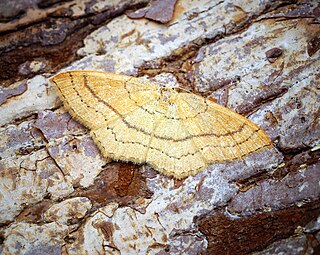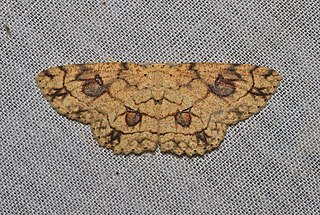
The geometer moths are moths belonging to the family Geometridae of the insect order Lepidoptera, the moths and butterflies. Their scientific name derives from the Ancient Greek geo γεω, and metron μέτρον "measure" in reference to the way their larvae, or "inchworms", appear to "measure the earth" as they move along in a looping fashion. A very large family, it has around 23,000 species of moths described, and over 1400 species from six subfamilies indigenous to North America alone. A well-known member is the peppered moth, Biston betularia, which has been subject of numerous studies in population genetics. Several other geometer moths are notorious pests.

Lepidurus is a genus of small crustaceans in the order Notostraca. It is the larger of the two extant genera of the tadpole shrimps, the other being Triops. They are commonly found in vernal pools and survive dry periods with the help of long lasting resting eggs.

Cyclophora albipunctata, the birch mocha, is a moth of the family Geometridae. The species was first described by Johann Siegfried Hufnagel in 1767. It is found in the Palearctic. The southern boundary runs westward along the French Atlantic coast and to the British Isles and north of the Alps. In the east, the species ranges to the Pacific Ocean. South of the northern Alps line, it is found at some high elevation areas and mountains. In the Pyrenees, the Massif Central, the southern Alps, the northern Dinaric Alps, in the western and northern Carpathians, in northern Turkey and the Caucasus. In the north, the range extends up to the Arctic Circle. In the Far East the nominate subspecies is replaced by Cyclophora albipunctata griseolataStaudinger, 1897.

Cyclophora porata, the false mocha, is a moth of the family Geometridae. The species can be found in southern Europe and England to Denmark, southern Sweden and the Caucasus.

Cyclophora punctaria, the maiden's blush, is a moth of the family Geometridae. The species was first described by Carl Linnaeus in his 1758 10th edition of Systema Naturae. The species is mainly prevalent in Central and Eastern Europe. In the north, its distribution extends to southern Fennoscandia and the British Isles, in the west via France to parts of northern Spain, in the south via Italy, the Balkan Peninsula to Asia Minor. The eastern border of the distribution is roughly the Ural. In the Caucasus area, the nominate subspecies is replaced by the subspecies C. punctaria fritzae. The range of this subspecies extends as far as Iran.Cyclophora punctaria is found mainly in wooded areas with oak scrub and oak forests. In Central Europe it rises up to 700 metres in the hills, rarely up to 1,200 metres in the Alps, and regularly rises to 1,300 metres in southern Europe.

Cyclophora puppillaria, or Blair's mocha, is a moth of the family Geometridae. The species was first described by Jacob Hübner in 1799. It can be found in Europe and from North Africa up to the Caucasus area.

Cyclophora linearia, the clay triple-lines, is a moth of the family Geometridae. The species was first described by Jacob Hübner in 1799 and it can be found in Europe and Britain.

Cyclophora ruficiliaria, the Jersey mocha, is a moth of the family Geometridae. The species was first described by Gottlieb August Wilhelm Herrich-Schäffer in 1855. It can be found in Europe, in particular the Channel Islands as well as other parts of the mainland United Kingdom.

Cyclophora annularia, the mocha, is a moth of the family Geometridae. The species was first described by Johan Christian Fabricius in 1775 and it can be found in Europe.

Cyclophora is a genus of moths in the family Geometridae. Many species are referred to as mochas in reference to their colouration, primarily in Europe.

Cyclophora nanaria, the dwarf tawny wave, is a moth of the family Geometridae. The species was first described by Francis Walker in 1861. It is found in the US from California to Texas and from New Jersey to Florida west along the Gulf Coast. The range extends south through Dominica and Jamaica to Argentina. It is an introduced species in Hawaii.

Cyclophora obstataria is a moth of the family Geometridae first described by Francis Walker in 1861. It is known from the Indian subregion, Sri Lanka and China to Sundaland, New Guinea and Queensland in Australia.
Digrammia subminiata, the vermillion granite or dark-waved angle, is a moth of the family Geometridae. The species was first described by Alpheus Spring Packard in 1873. It is found in western North America from British Columbia to Manitoba, south through Colorado to Arizona and California.

Cyclophora lennigiaria is a moth in the family Geometridae. It is found in south-western Europe, north to southern France and western Germany, as well as in Morocco.
Cyclophora maderensis is a moth in the family Geometridae. It is found on the Canary Islands and Madeira.
Cyclophora myrtaria, the waxmyrtle wave moth, is a moth in the family Geometridae. It is found in North America, where it is found along the Atlantic ocean plane.

Cyclophora pendulinaria, the sweetfern geometer moth or pearly-grey wave, is a moth in the family Geometridae. It is found in North America, where it is found from Newfoundland and Labrador west to the Yukon and coastal British Columbia, south to Georgia in the east. The habitat consists of moist or mesic forests.

Cyclophora heydena is a moth in the family Geometridae first described by Charles Swinhoe in 1894. It is found in the north-eastern Himalayas and on Borneo and Java.
















